A Dynamic Large-Scale Driving-Force to Control the Targeted Wind Speed in Large Eddy Simulations above Ocean Waves
Abstract
1. Introduction
2. Methods
2.1. Numerical Problem Formulation
2.1.1. Governing Equations and Boundary Conditions
- Upper Boundary Conditions
- Lower Boundary Conditions
2.1.2. Post-Processing
- Surface Drag and Friction Velocity
- Averages, Fluctuations, and Fluxes
2.1.3. Numerical Strategy
- Discretization
- Initialization
2.2. A Large-Scale Dynamically Evolving Pressure Gradient Modeler
3. Pilot Application
- Test Cases
- Results
4. Flat-Bottom Application
- Test Cases
4.1. Evolution and Turbulent Profiles
4.2. Wind Velocity Profiles and Fitting
5. Wave Age Variation
- Test Cases
5.1. Time Histories
5.2. Wind Velocity Profiles
5.3. Form Drag Parametrization
5.4. Turbulent Profiles
- Turbulent Normal Stresses
- Turbulent Shear stresses
6. Discussion
6.1. Reviewing the Mathematical Formulation of a Physical MABL in LES
6.2. A Simplified Framework
6.3. Evaluating Standard LES Formulations of the MABL
6.4. Large-Scale Dynamically Evolving Pressure Gradient Modeler
6.5. WI Disturbances and WA Parametrization
7. Conclusions
Author Contributions
Funding
Data Availability Statement
Acknowledgments
Conflicts of Interest
References
- Thomson, W. Hydrokinetic Solutions and Observations. Philos. Mag. 1871, 42, 326–378. [Google Scholar] [CrossRef]
- Jeffreys, H. On the formation of water waves by wind. Proc. R. Soc. Lond. 1925, 107, 189–206. [Google Scholar]
- Miles, J.W. On The Generation Of Surface Waves By Shear Flows, PartI. J. Fluid Mech. 1957, 3, 185–204. [Google Scholar] [CrossRef]
- Phillips, O.M. On The Generation Of Waves By Turbulent Wind. J. Fluid Mech. 1957, 2, 417–445. [Google Scholar] [CrossRef]
- Belcher, S.E.; Hunt, J.C.R. Turbulent Shear Flow Over Slowly Moving Waves. J. Fluid Mech. 1993, 251, 109–148. [Google Scholar] [CrossRef]
- Edson, J.B.; Zappa, C.J.; Ware, J.A.; McGillis, W.R.; Hare, J.E. Scalar flux profile relationships over the open ocean. J. Geophys. Res. Ocean. 2004, 109, C8. [Google Scholar] [CrossRef]
- Grare, L.; Lenain, L.; Melville, W.K. Wave-Coherent Airflow and Critical Layers over Ocean Waves. J. Phys. Oceanogr. 2013, 43, 2156–2172. [Google Scholar] [CrossRef]
- Bourras, D.; Branger, H.; Reverdin, G.; Marié, L.; Cambra, R.; Baggio, L.; Caudoux, C.; Caudal, G.; Morisset, S.; Geyskens, N.; et al. A New Platform for the Determination of Air–Sea Fluxes (OCARINA): Overview and First Results. J. Atmos. Ocean. Technol. 2014, 31, 1043–1062. [Google Scholar] [CrossRef]
- Tamura, H.; Drennan, W.M.; Collins, C.O.; Graber, H.C. Turbulent Airflow and Wave-Induced Stress Over the Ocean. Bound.-Layer Meteorol. 2018, 169, 47–66. [Google Scholar] [CrossRef]
- Paskin, L.; Conan, B.; Perignon, Y.; Aubrun, S. Evidence of Ocean Waves Signature in the Space–Time Turbulent Spectra of the Lower Marine Atmosphere Measured by a Scanning LiDAR. Remote Sens. 2022, 14, 3007. [Google Scholar] [CrossRef]
- Hristov, T. Mechanistic, empirical and numerical perspectives on wind-waves interaction. Procedia IUTAM 2018, 26, 102–111. [Google Scholar] [CrossRef]
- Harris, J.A.; Belcher, S.E.; Street, R.L. Linear dynamics of wind waves in coupled turbulent air–water flow. Part 2. Numerical model. J. Fluid Mech. 1996, 308, 219–254. [Google Scholar] [CrossRef]
- Ayet, A.; Chapron, B. The Dynamical Coupling of Wind-Waves and Atmospheric Turbulence: A Review of Theoretical and Phenomenological Models. Bound.-Layer Meteorol. 2022, 183, 1–33. [Google Scholar] [CrossRef]
- Yousefi, K.; Veron, F. Boundary layer formulations in orthogonal curvilinear coordinates for flow over wind-generated surface waves. J. Fluid Mech. 2020, 888, A11. [Google Scholar] [CrossRef]
- Ayet, A. Air-Sea Momentum Fluxes in the Vicinity of the Sea Surface: A Theoretical Study of the Coupling between Turbulence and Wind-Waves. Ph.D. Thesis, Université de Bretagne Occidentale, Brest, France, 2020. [Google Scholar]
- Smedman, A.; Högström, U.; Bergström, H.; Rutgersson, A.; Kahma, K.K.; Pettersson, H. A case study of air-sea interaction during swell conditions. J. Geophys. Res. Ocean. 1999, 104, 25833–25851. [Google Scholar] [CrossRef]
- Harris, D.L. The Wave-Driven Wind. J. Atmos. Sci. 1966, 23, 688–693. [Google Scholar] [CrossRef]
- Hanley, K.E.; Belcher, S.E. Wave-Driven Wind Jets in the Marine Atmospheric Boundary Layer. J. Atmos. Sci. 2008, 65, 2646–2660. [Google Scholar] [CrossRef]
- Sjöblom, A.; Smedman, A.S. The turbulent kinetic energy budget in the marine atmospheric surface layer. J. Geophys. Res. Ocean. 2002, 107, 6–18. [Google Scholar] [CrossRef]
- Cifuentes-Lorenzen, A.; Edson, J.B.; Zappa, C.J. Air–Sea Interaction in the Southern Ocean: Exploring the Height of the Wave Boundary Layer at the Air–Sea Interface. Bound.-Layer Meteorol. 2018, 169, 461–482. [Google Scholar] [CrossRef]
- Chalikov, D.; Babanin, A.V. Parameterization of Wave Boundary Layer. Atmosphere 2019, 10, 686. [Google Scholar] [CrossRef]
- Semedo, A.; Saetra, Ø.; Rutgersson, A.; Kahma, K.K.; Pettersson, H. Wave-Induced Wind in the Marine Boundary Layer. J. Atmos. Sci. 2009, 66, 2256–2271. [Google Scholar] [CrossRef]
- Liu, C.; Li, X.; Song, J.; Zou, Z.; Huang, J.; Zhang, J.A.; Jie, G.; Wang, J. Characteristics of the Marine Atmospheric Boundary Layer under the Influence of Ocean Surface Waves. J. Phys. Oceanogr. 2022, 52, 1261–1276. [Google Scholar] [CrossRef]
- Janssen, P.A.E.M.; Breivik, Ø.; Mogensen, K.; Vitart, F.; Alonso-Balmaseda, M.; Bidlot, J.R.; Keeley, S.; Leutbecher, M.; Magnusson, L.; Molteni, F. Air-sea interaction and surface waves. ECMWF Tech. Memo. 2013, 712, 1–34. [Google Scholar]
- Li, H.; Claremar, B.; Wu, L.; Hallgren, C.; Körnich, H.; Ivanell, S.; Sahlée, E. A sensitivity study of the WRF model in offshore wind modeling over the Baltic Sea. Geosci. Front. 2021, 12, 101229. [Google Scholar] [CrossRef]
- Rezaeiha, A.; Pereira, R.; Kotsonis, M. Fluctuations of angle of attack and lift coefficient and the resultant fatigue loads for a large Horizontal Axis Wind turbine. Renew. Energy 2017, 114, 904–916. [Google Scholar] [CrossRef]
- Leroy, V.; Gilloteaux, J.C.; Lynch, M.; Babarit, A.; Ferrant, P. Impact of aerodynamic modeling on seakeeping performance of a floating horizontal axis wind turbine. Wind Energy 2019, 22, 1019–1033. [Google Scholar] [CrossRef]
- Kalvig, S.; Gudmestad, O.T.; Winther, N. Exploring the gap between ‘best knowledge’ and ‘best practice’ in boundary layer meteorology for offshore wind energy. Wind Energy 2014, 17, 161–171. [Google Scholar] [CrossRef]
- Obukhov, A.M. Turbulence in an Atmosphere with a Non-Uniform Temperature. Bound.-Layer Meteorol. 1946, 2, 7–29. [Google Scholar] [CrossRef]
- Monin, A.S.; Obukhov, A.M. Basic Laws of Turbulent Mixing in the Surface Layer of the Atmosphere. Contrib. Geophys. Inst. Acad. Sci. USSR 1954, 24, 163–187. [Google Scholar]
- Edson, J.B.; Fairall, C.W. Similarity Relationships in the Marine Atmospheric Surface Layer for Terms in the TKE and Scalar Variance Budgets. J. Atmos. Sci. 1998, 55, 2311–2328. [Google Scholar] [CrossRef]
- Hristov, T.; Ruiz-Plancarte, J. Dynamic Balances in a Wavy Boundary Layer. J. Phys. Oceanogr. 2014, 44, 3185–3194. [Google Scholar] [CrossRef]
- Charnock, H. Wind stress on a water surface. Q. J. R. Meteorol. Soc. 1955, 81, 639–640. [Google Scholar] [CrossRef]
- Donelan, M.A.; Dobson, F.W.; Smith, S.D.; Anderson, R.J. On the Dependence of Sea Surface Roughness on Wave Development. J. Phys. Oceanogr. 1993, 23, 2143–2149. [Google Scholar] [CrossRef]
- Edson, J.B.; Jampana, V.; Weller, R.A.; Bigorre, S.P.; Plueddemann, A.J.; Fairall, C.W.; Miller, S.D.; Mahrt, L.; Vickers, D.; Hersbach, H. On the Exchange of Momentum over the Open Ocean. J. Phys. Oceanogr. 2013, 43, 1589–1610. [Google Scholar] [CrossRef]
- Patton, E.G.; Sullivan, P.P.; Kosović, B.; Dudhia, J.; Mahrt, L.; Žagar, M.; Marić, T. On the Influence of Swell Propagation Angle on Surface Drag. J. Appl. Meteorol. Climatol. 2019, 58, 1039–1059. [Google Scholar] [CrossRef]
- Porchetta, S.; Temel, O.; Muñoz Esparza, D.; Reuder, J.; Monbaliu, J.; van Beeck, J.; van Lipzig, N. A new roughness length parameterization accounting for wind–wave (mis)alignment. Atmos. Chem. Phys. 2019, 19, 6681–6700. [Google Scholar] [CrossRef]
- Sullivan, P.P.; McWilliams, J.C.; Moeng, C.H. Simulation of turbulent flow over idealized water waves. J. Fluid Mech. 2000, 404, 47–85. [Google Scholar] [CrossRef]
- Yang, D.; Shen, L. Characteristics of coherent vortical structures in turbulent flows over progressive surface waves. Phys. Fluids 2009, 21, 125106. [Google Scholar] [CrossRef]
- Yang, D.; Shen, L. Direct-simulation-based study of turbulent flow over various waving boundaries. J. Fluid Mech. 2010, 650, 131–180. [Google Scholar] [CrossRef]
- Yang, D.; Shen, L. Simulation of viscous flows with undulatory boundaries. Part I: Basic solver. J. Comput. Phys. 2011, 230, 5488–5509. [Google Scholar] [CrossRef]
- Druzhinin, O.A.; Troitskaya, Y.I.; Zilitinkevich, S.S. Direct numerical simulation of a turbulent wind over a wavy water surface. J. Geophys. Res. Ocean. 2012, 117, C11. [Google Scholar] [CrossRef]
- Yang, Z.; Deng, B.Q.; Shen, L. Direct numerical simulation of wind turbulence over breaking waves. J. Fluid Mech. 2018, 850, 120–155. [Google Scholar] [CrossRef]
- Deskos, G.; Ananthan, S.; Sprague, M.A. Direct numerical simulations of turbulent flow over misaligned traveling waves. Int. J. Heat Fluid Flow 2022, 97, 109029. [Google Scholar] [CrossRef]
- Stoll, R.; Gibbs, J.A.; Salesky, S.T.; Anderson, W.; Calaf, M. Large-Eddy Simulation of the Atmospheric Boundary Layer. Bound.-Layer Meteorol. 2020, 177, 541–581. [Google Scholar]
- Chanprasert, W.; Sharma, R.; Cater, J.; Norris, S. Large Eddy Simulation of wind turbine fatigue loading and yaw dynamics induced by wake turbulence. Renew. Energy 2022, 190, 208–222. [Google Scholar] [CrossRef]
- Henn, D.S.; Sykes, R.I. Large-eddy simulation of flow over wavy surfaces. J. Fluid Mech. 1999, 383, 75–112. [Google Scholar] [CrossRef]
- Sullivan, P.P.; Edson, J.B.; Hristov, T.; McWilliams, J.C. Large-Eddy Simulations and Observations of Atmospheric Marine Boundary Layers above Nonequilibrium Surface Waves. J. Atmos. Sci. 2008, 65, 1225–1245. [Google Scholar] [CrossRef]
- Sullivan, P.P.; McWilliams, J.C.; Patton, E.G. Large-Eddy Simulation of Marine Atmospheric Boundary Layers above a Spectrum of Moving Waves. J. Atmos. Sci. 2014, 71, 4001–4027. [Google Scholar] [CrossRef]
- Hara, T.; Sullivan, P.P. Wave Boundary Layer Turbulence over Surface Waves in a Strongly Forced Condition. J. Phys. Oceanogr. 2015, 45, 868–883. [Google Scholar] [CrossRef]
- Cathelain, M. Development of a Deterministic Numerical Model for the Study of the Coupling between an Atmospheric Flow and a Sea State. Ph.D. Thesis, Ecole Centrale de Nantes (ECN), Nantes, France, 2017. [Google Scholar]
- Paskin, L.; Perignon, Y.; Conan, B.; Aubrun, S. Numerical study on the Wave Boundary Layer, its interaction with turbulence and consequences on the wind energy resource in the offshore environment. J. Phys. Conf. Ser. 2020, 1618, 062046. [Google Scholar] [CrossRef]
- Yang, D.; Meneveau, C.; Shen, L. Dynamic modelling of sea-surface roughness for large-eddy simulation of wind over ocean wavefield. J. Fluid Mech. 2013, 726, 62–99. [Google Scholar] [CrossRef]
- Yang, D.; Meneveau, C.; Shen, L. Effect of downwind swells on offshore wind energy harvesting—A large-eddy simulation study. Renew. Energy 2014, 70, 11–23. [Google Scholar] [CrossRef]
- Yang, D.; Meneveau, C.; Shen, L. Large-eddy simulation of offshore wind farm. Phys. Fluids 2014, 26, 025101. [Google Scholar] [CrossRef]
- Hao, X.; Shen, L. Wind–wave coupling study using LES of wind and phase-resolved simulation of nonlinear waves. J. Fluid Mech. 2019, 874, 391–425. [Google Scholar] [CrossRef]
- Hao, X.; Cao, T.; Shen, L. Mechanistic study of shoaling effect on momentum transfer between turbulent flow and traveling wave using large-eddy simulation. Phys. Rev. Fluids 2021, 6, 054608. [Google Scholar] [CrossRef]
- Cao, T.; Shen, L. A numerical and theoretical study of wind over fast-propagating water waves. J. Fluid Mech. 2021, 919, A38. [Google Scholar] [CrossRef]
- Hao, X.; Shen, L. Large-eddy simulation of gusty wind turbulence over a travelling wave. J. Fluid Mech. 2022, 946, A8. [Google Scholar] [CrossRef]
- Deskos, G.; Lee, J.C.Y.; Draxl, C.; Sprague, M.A. Review of Wind–Wave Coupling Models for Large-Eddy Simulation of the Marine Atmospheric Boundary Layer. J. Atmos. Sci. 2021, 78, 3025–3045. [Google Scholar] [CrossRef]
- Pedersen, J.G.; Kelly, M.; Gryning, S.E.; Brümmer, B. The effect of unsteady and baroclinic forcing on predicted wind profiles in Large Eddy Simulations: Two case studies of the daytime atmospheric boundary layer. Meteorologische Zeitschrift 2013, 22, 661–674. [Google Scholar] [CrossRef]
- Basu, S.; Vinuesa, J.; Swift, A. Dynamic LES Modeling of a Diurnal Cycle. J. Appl. Meteorol. Climatol. 2008, 47, 1156–1174. [Google Scholar] [CrossRef]
- Nielson, J.; Bhaganagar, K. Capturing Day-to-day Diurnal Variations in Stability in the Convective Atmospheric Boundary Layer Using Large Eddy Simulation. Open Atmos. Sci. J. 2018, 12, 107–131. [Google Scholar] [CrossRef]
- Allaerts, D.; Quon, E.; Draxl, C.; Churchfield, M. Development of a Time–Height Profile Assimilation Technique for Large-Eddy Simulation. Bound.-Layer Meteorol. 2020, 176, 329–348. [Google Scholar] [CrossRef]
- Draxl, C.; Allaerts, D.; Quon, E.; Churchfield, M. Coupling Mesoscale Budget Components to Large-Eddy Simulations for Wind-Energy Applications. Bound.-Layer Meteorol. 2021, 179, 73–98. [Google Scholar] [CrossRef]
- Pimont, F.; Dupuy, J.L.; Linn, R.R.; Sauer, J.A.; Muñoz-Esparza, D. Pressure-Gradient Forcing Methods for Large-Eddy Simulations of Flows in the Lower Atmospheric Boundary Layer. Atmosphere 2020, 11, 1343. [Google Scholar] [CrossRef]
- Stieren, A.; Gadde, S.N.; Stevens, R.J. Modeling dynamic wind direction changes in large eddy simulations of wind farms. Renew. Energy 2021, 170, 1342–1352. [Google Scholar] [CrossRef]
- Fenton, J.D. A fifth-order Stokes theory for steady waves. J. Waterw. Port Coastal Ocean. Eng. 1985, 111, 216–234. [Google Scholar] [CrossRef]
- Spiegel, E.A.; Veronis, G. On The Boussinesq Approximation For A Compressible Fluid. Astrophys. J. 1960, 131, 442. [Google Scholar] [CrossRef]
- Moeng, C.H. A Large-Eddy-Simulation Model for the Study of Planetary Boundary-Layer Turbulence. J. Atmos. Sci. 1984, 41, 2052–2062. [Google Scholar] [CrossRef]
- Thomas, P.D.; Lombard, C.K. Geometric Conservation Law and Its Application to Flow Computations on Moving Grids. AIAA J. 1979, 17, 1030–1037. [Google Scholar] [CrossRef]
- Kleppner, D.; Kolenkow, R. An Introduction to Mechanics, 1st ed.; Cambridge University Press: Cambridge, UK, 2010; pp. 410–440. [Google Scholar]
- Georgi, H. The Physics of Waves, 1st ed.; Prentice Hall: Englewood Cliffs, NJ, USA, 1993; pp. 1–52. [Google Scholar]
- Lighthill, M.J. Physical interpretation of the mathematical theory of wave generation by wind. J. Fluid Mech. 1962, 14, 385–398. [Google Scholar] [CrossRef]
- Hristov, T.S.; Miller, S.D.; Friehe, C.A. Dynamical coupling of wind and ocean waves through wave-induced air flow. Nature 2003, 422, 55–58. [Google Scholar] [CrossRef] [PubMed]
- Donelan, M.; Babanin, A.; Young, I.; Banner, M. Wave-Follower Field Measurements of the Wind-Input Spectral Function. Part II: Parameterization of the Wind Input. J. Phys. Oceanogr. 2006, 36, 1672–1689. [Google Scholar] [CrossRef]
- Högström, U.; Smedman, A.; Sahleé, E.; Drennan, W.M.; Kahma, K.K.; Pettersson, H.; Zhang, F. The Atmospheric Boundary Layer during Swell: A Field Study and Interpretation of the Turbulent Kinetic Energy Budget for High Wave Ages. J. Atmos. Sci. 2009, 66, 2764–2779. [Google Scholar] [CrossRef]
- O’Sullivan, J.; Archer, R.; Flay, R. Consistent boundary conditions for flows within the atmospheric boundary layer. J. Wind. Eng. Ind. Aerodyn. 2011, 99, 65–77. [Google Scholar] [CrossRef]
- Donelan, M.A.; Drennan, W.M.; Magnusson, A.K. Nonstationary Analysis of the Directional Properties of Propagating Waves. J. Phys. Oceanogr. 1996, 26, 1901–1914. [Google Scholar] [CrossRef]
- Mastenbroek, C. Wind–Wave Interaction. Ph.D. Thesis, TU Delft, Delft, The Netherlands, 1996. [Google Scholar]


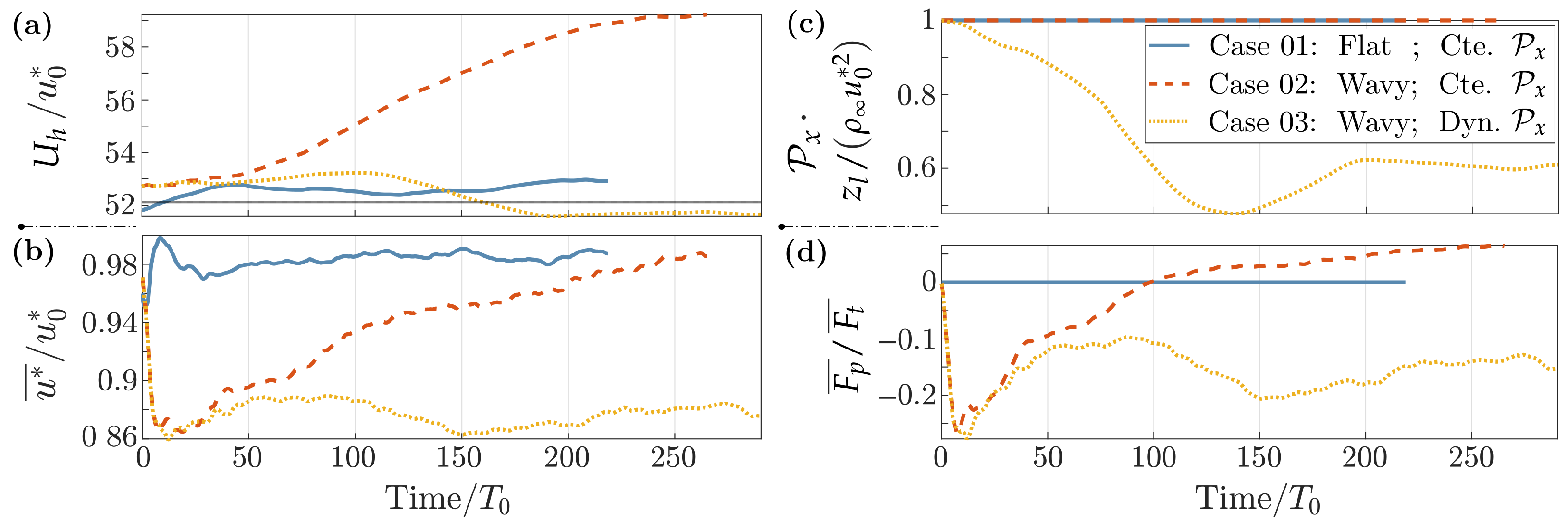




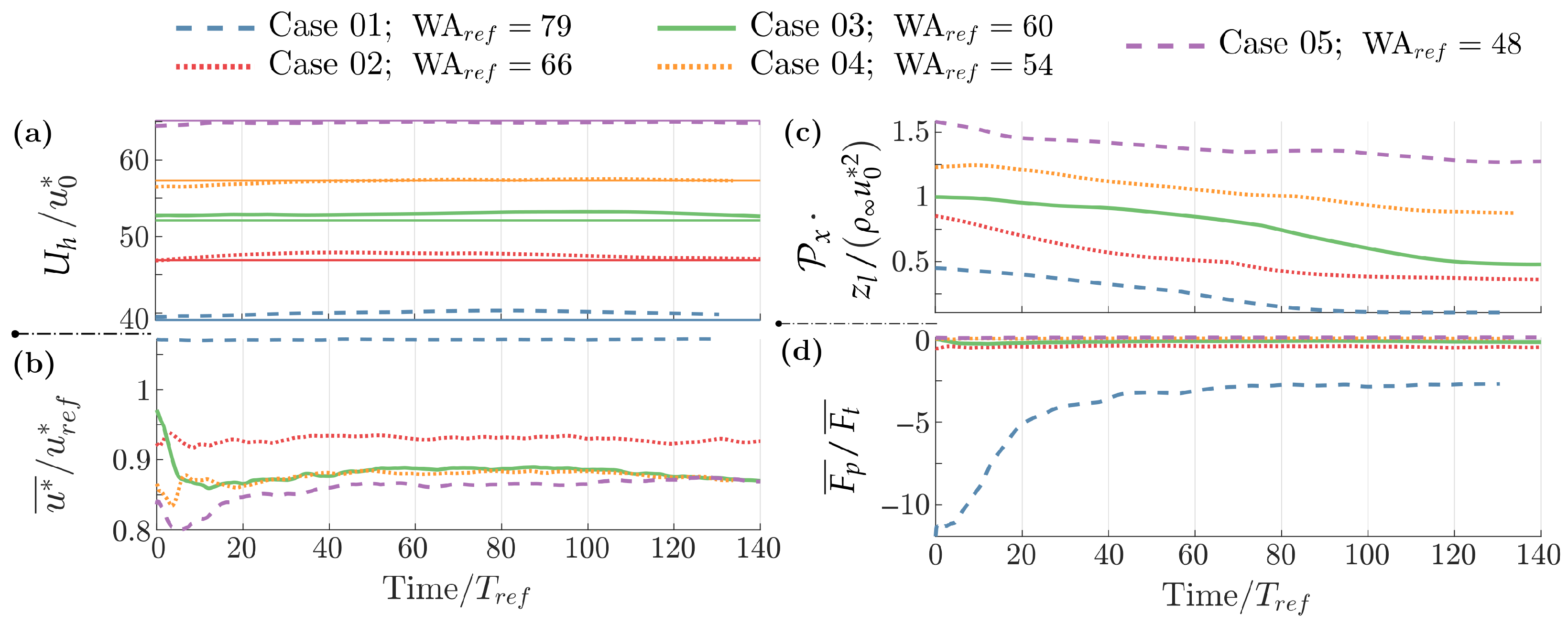
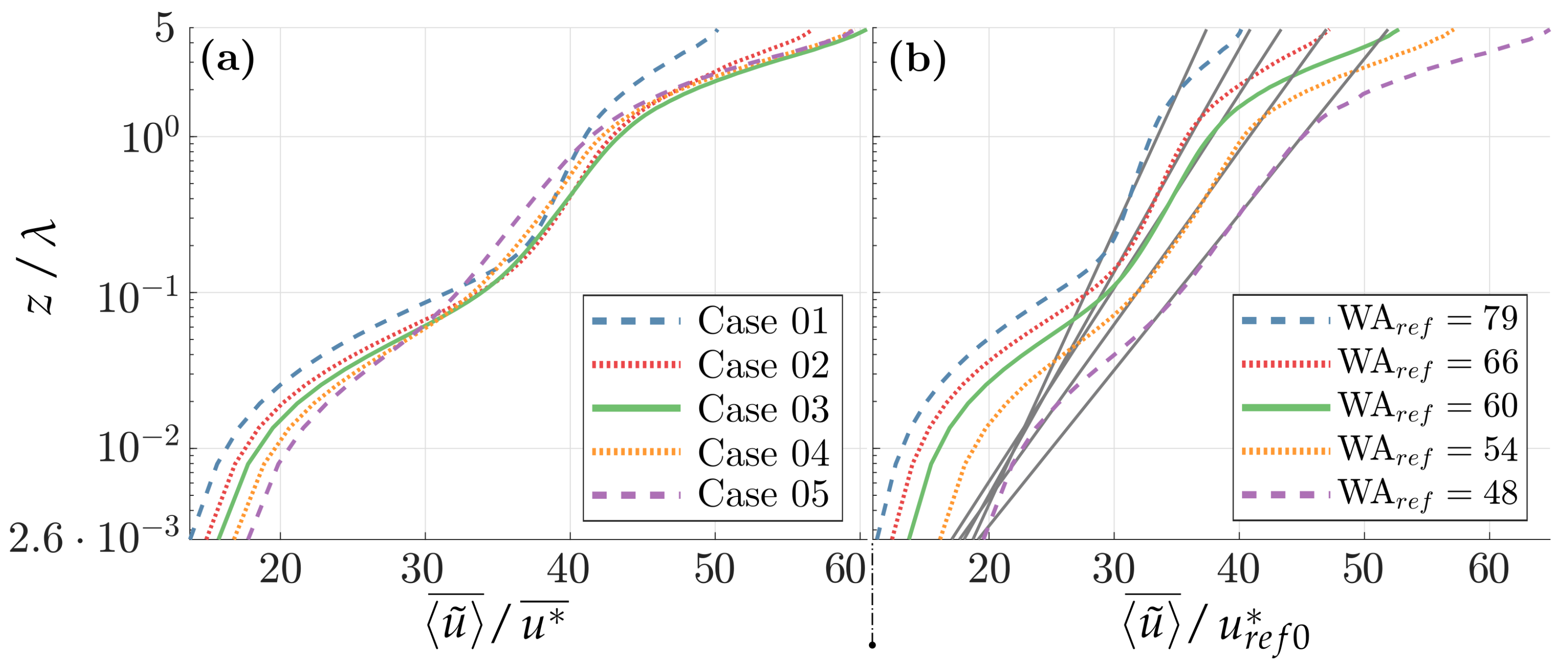

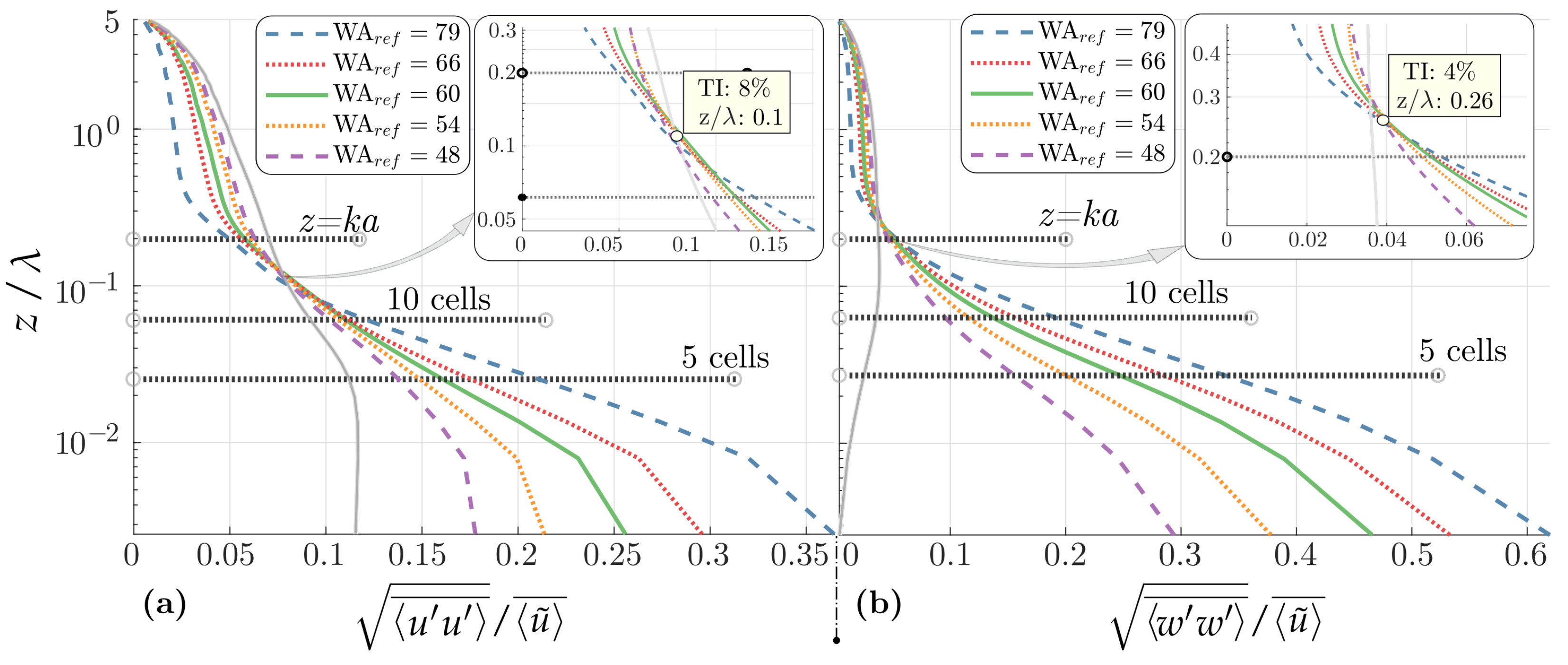
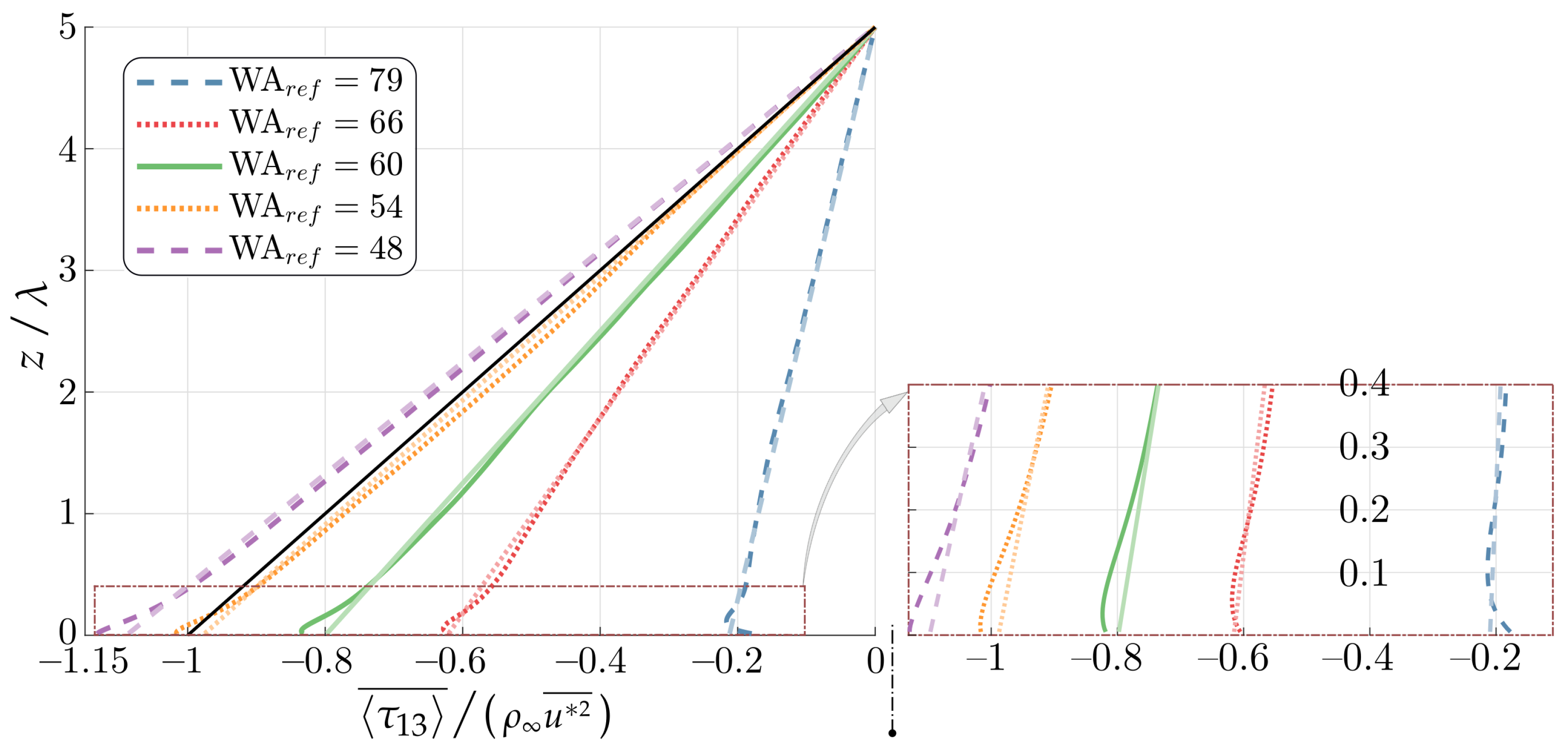
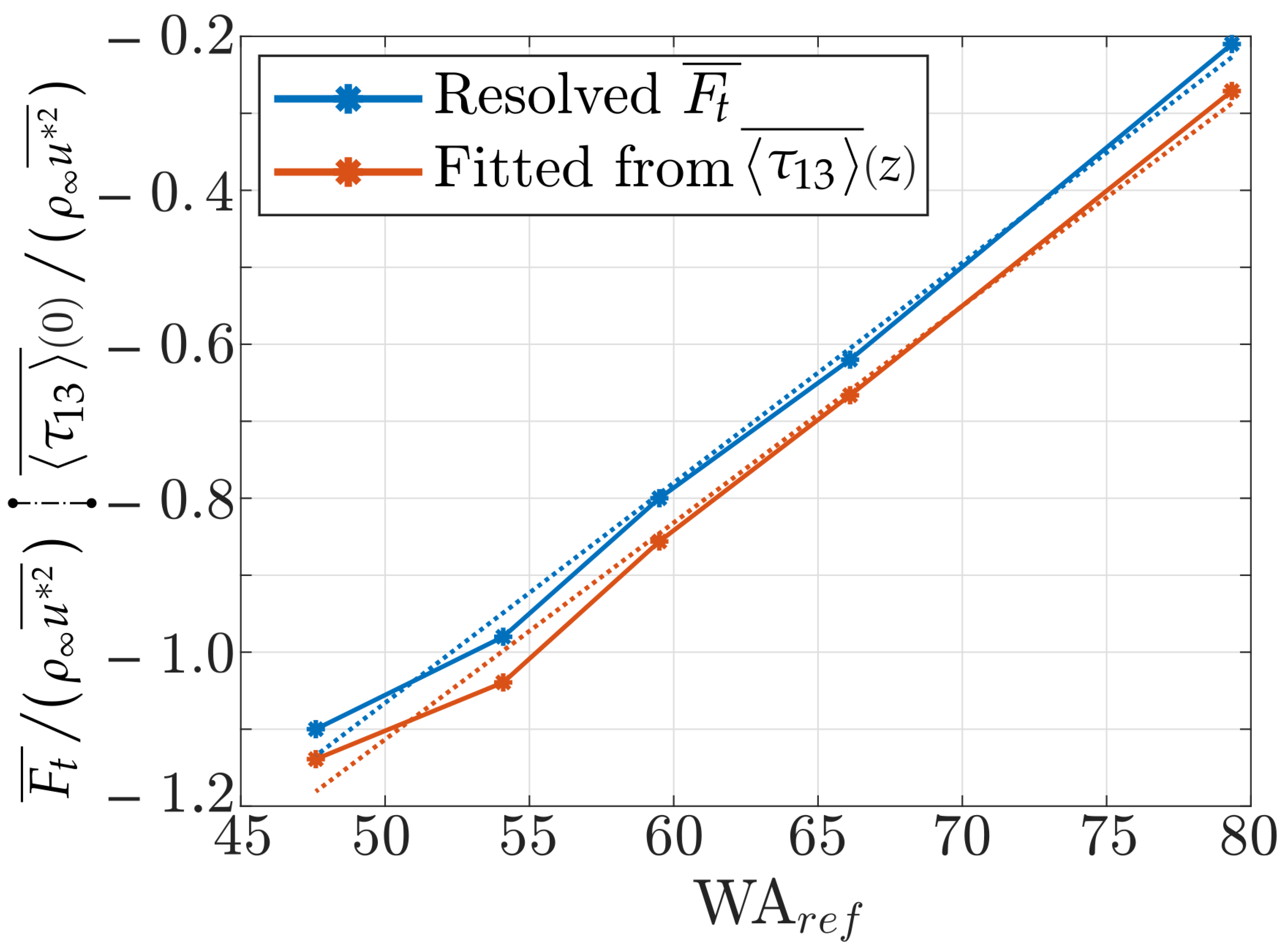
| Case ID | WA | WA | ||||
|---|---|---|---|---|---|---|
| 1 | 0.75 | 1.85% | 0.107 | 1.073 | 79 | 74 |
| 2 | 0.90 | 0.18% | 0.361 | 0.926 | 66 | 72 |
| 3 | 1.00 | 1.24% | 0.479 | 0.871 | 60 | 68 |
| 4 | 1.10 | −0.04% | 0.876 | 0.870 | 54 | 62 |
| 5 | 1.25 | −0.49% | 1.270 | 0.869 | 48 | 55 |
| iCase | WA | |||
|---|---|---|---|---|
| 1 | 79 | 0.94 | 0.03 | 0.18 |
| 2 | 66 | 1.40 | 4.16 | 0.14 |
| 3 | 60 | 1.48 | 9.41 | 0.11 |
| 4 | 54 | 1.57 | 20.09 | 0.08 |
| 5 | 48 | 1.58 | 29.01 | 0.06 |
| Flat | – | 0.93 ± 0.03 | 0.43 ± 0.16 | 0.03 |
| Case ID | WA | |
|---|---|---|
| 1 | 79 | −0.21 |
| 2 | 66 | −0.62 |
| 3 | 60 | −0.80 |
| 4 | 54 | −0.98 |
| 5 | 48 | −1.10 |
| Case ID | A | B |
|---|---|---|
| Resolved | 2.84 | −2.54 |
| Fitted from | 2.84 | −2.48 |
Publisher’s Note: MDPI stays neutral with regard to jurisdictional claims in published maps and institutional affiliations. |
© 2022 by the authors. Licensee MDPI, Basel, Switzerland. This article is an open access article distributed under the terms and conditions of the Creative Commons Attribution (CC BY) license (https://creativecommons.org/licenses/by/4.0/).
Share and Cite
Paskin, L.; Conan, B.; Perignon, Y.; Aubrun, S. A Dynamic Large-Scale Driving-Force to Control the Targeted Wind Speed in Large Eddy Simulations above Ocean Waves. Atmosphere 2022, 13, 2012. https://doi.org/10.3390/atmos13122012
Paskin L, Conan B, Perignon Y, Aubrun S. A Dynamic Large-Scale Driving-Force to Control the Targeted Wind Speed in Large Eddy Simulations above Ocean Waves. Atmosphere. 2022; 13(12):2012. https://doi.org/10.3390/atmos13122012
Chicago/Turabian StylePaskin, Liad, Boris Conan, Yves Perignon, and Sandrine Aubrun. 2022. "A Dynamic Large-Scale Driving-Force to Control the Targeted Wind Speed in Large Eddy Simulations above Ocean Waves" Atmosphere 13, no. 12: 2012. https://doi.org/10.3390/atmos13122012
APA StylePaskin, L., Conan, B., Perignon, Y., & Aubrun, S. (2022). A Dynamic Large-Scale Driving-Force to Control the Targeted Wind Speed in Large Eddy Simulations above Ocean Waves. Atmosphere, 13(12), 2012. https://doi.org/10.3390/atmos13122012






